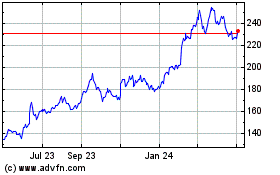China Auto Sales Lag Guidance - Analyst Blog
January 14 2013 - 8:05AM
Zacks
According to the China Association of Automobile Manufacturers
(CAAM), vehicle sales in China grew 4.3% to 19.3 million units in
2012, including a 7.1% gain in December to 1.8 million units.
Despite being higher than the 2011-level of 2.5%, sales growth is
lower than the 8% growth projected by CAAM as well as the
double-digit growth in 2009 and 2010.
The lower-than-expected growth can be attributable to a sluggish
economy, rising fuel costs, weak Japanese automakers sales owing to
a conflict between Beijing and Tokyo, and drastic steps take by few
major cities to curb traffic congestion and emission levels.
Sales by Automakers
The U.S. automakers, including General Motors
Company (GM) and Ford Motor Co. (F),
performed quite well in China in 2012. GM posted an impressive
23.2% rise in sales to 242,486 vehicles, driven mainly by a hefty
41.7% gain in sales at its joint-venture with SAIC Motor Corp. For
the full year, the company’s sales grew 11.3% to 2.84 million
units. Meanwhile, Ford sold 626,616 vehicles in the year, up 21%
from 2011. The company’s December sales surged 43% to 70,510
vehicles.
Sales of Japanese automakers lagged due to the above-mentioned
conflict. Sales of Toyota Motor Corp. (TM) slid
4.9% to 840,000 vehicles in 2012, including a fall of 16% in
December to 90,400 vehicles. However, the automaker is optimistic
about 2013. It expects sales growth of 7% in 2013, which is higher
than its global target of 2%.
Sales of Honda Motor Co. (HMC) dipped 3.1% to
598,577 vehicles in the year, including a significant 19.2% fall in
December to 63,264 vehicles. Sales of Nissan Motor
Co. (NSANY) slipped 5.3% to 1.18 million vehicles in the
year. The automaker sold 90,400 vehicles in December.
Among the other automakers, Daimler AG (DDAIF)
reported a 4% rise in sales to 206,150 vehicles in 2012. Meanwhile,
Volkswagen AG (VLKAY) sold 2.81 million vehicles
in the year, up 24.5% from 2011.
2013 Outlook
According to CAAM, auto sales in China are expected to rise 7% to
more than 20 million vehicles in 2013, led by strong demand for
passenger vehicles and economic recovery. The association believes
sports utility vehicles (SUVs) will remain the fastest- growing
segment in the year while commercial vehicles will record a
moderate gain in sales.
China Versus U.S.
Auto sales in China had grown at a double-digit pace since 1999,
except in 2008 when the global economic crisis crept in. In 2009,
China overtook the U.S. as the biggest auto market in the world by
sales volumes when the Beijing government introduced a stimulus
package, including tax incentives for small cars. China accounted
for a third of light vehicle sales growth in the last five
years.
Auto sales in the U.S. grew 13.4% to the five-year high of 14.5
million vehicles in 2012 including a 9% rise to 1.4 million in
December last year. A host of macroeconomic factors helped the
industry reach the height. They include improving consumer
confidence, falling unemployment and improvement in home sales and
prices.
Sales were also fueled by strong pent-up demand, due to both aging
vehicles (average age of a car reached 11 years) and the need to
replace damaged vehicles from Hurricane Sandy. Banks were also
friendlier as they offered greater access to loans with lower
interest rates.
DAIMLER AG (DDAIF): Free Stock Analysis Report
FORD MOTOR CO (F): Free Stock Analysis Report
GENERAL MOTORS (GM): Free Stock Analysis Report
HONDA MOTOR (HMC): Free Stock Analysis Report
NISSAN ADR (NSANY): Free Stock Analysis Report
TOYOTA MOTOR CP (TM): Free Stock Analysis Report
(VLKAY): ETF Research Reports
To read this article on Zacks.com click here.
Zacks Investment Research
Toyota Motor (NYSE:TM)
Historical Stock Chart
From Jun 2024 to Jul 2024

Toyota Motor (NYSE:TM)
Historical Stock Chart
From Jul 2023 to Jul 2024
